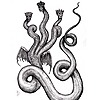HOME | DD
 salpfish1 — Endoparasitic Conifer Descendants
salpfish1 — Endoparasitic Conifer Descendants

#evolution #future #parasite #parasitic #speculative #tapeworm #futureevolution #speculativeevolution #speculativebiology #parasitecreature
Published: 2017-06-16 00:50:13 +0000 UTC; Views: 7525; Favourites: 77; Downloads: 12
Redirect to original
Description
For 's competition inIn the distant future, around 100 MYH, a large mammal descendant accidentally ingested a conifer seed. Already a very generalist species that grew as a parasite on all kinds of plants and fungi, it sprouted in the animal's intestines and thrived with all of the nutrients there. This individual plant was even more accepting of different substrates than most members of its species, allowing it to grow inside this other creature. It eventually killed the animal, blocking its intestines. After it started decomposing, the plant bore fruiting bodies. It was a very successful individual, with thousands of seeds surviving. A few of those, with their new adaptations, had similar results and were equally successful. As evolution progressed, they adapted to this new lifestyle, producing fruit targeted at potential host animals and being capable of living inside of animals without killing them.
The species at the top lives much like a tapeworm. It uses a long, trailing root and densely packed root hairs to absorb as much nutrients as possible, most nutrients going towards the production of pollen and eggs. A single flower at the "head" end produces a lot of pollen, which is excreted by the animal and eaten by dung-feeding insects, which are in turn eaten by the insectivores that host other intestinal conifer descendants. The flower can also receive pollen, only accepting that of other individuals. It then stores the pollen, reusing it to produce as many seeds as possible. These seeds have a small, sharp root pressed against the seed's casing for most of the time, but in the intestine, certain digestive enzymes trigger this root to open up. This makes the seed catch on the intestine wall, allowing it to grow. In some varieties with separate male and female individuals, the male seed will open up in the jejunum (the second section of the small intestine), while the female opens up in the ileum (the third section of the small intestine). This ensures that females will be farther down the intestinal tract than males, so they are more likely to be fertilized by the male farther up the tract. The different sections are distinguished by different types of enzymes. Claws, derived from leaves, are used to grasp the intestine wall.
The second species is a more distant descendant, from around 150 MYH. It actually penetrates the intestine wall, and is little more than a root system. It grows throughout the entire animal, targeting non-essential organs to feed on. Swollen sections of the root are used to store nutrients so that the plant can live once the animal dies. Unusually for a plant, some types have genes that play the same role as HOX genes in animals, making different types of cells grow in different areas. This lets them grow toward specific organs with great accuracy. A few later types from around 160 MYH can control the nervous systems of their first host, usually a small animal. The goal is to get the smaller animal eaten by a larger, more nutritious animal, so it makes them more bold, have slower reflexes, and be attracted to open spaces. This results in them being eaten by a predator, which is the parasite's final stage of development. If the plant is lucky, the predator will feed the small animal to its young, spreading it to more than one animal. Their flowers are usually produced after the host dies, sprouting out of their sides and using insect or wind-pollinated flowers.
Related content
Comments: 13

👍: 0 ⏩: 0

This is one very unique, and somewhat disturbing idea.
I love them.
👍: 0 ⏩: 1

Finally an answer to the question philosophers and theologians have asked since the beginning: What do you get when you cross a fir tree with a tapeworm?
👍: 0 ⏩: 1






















